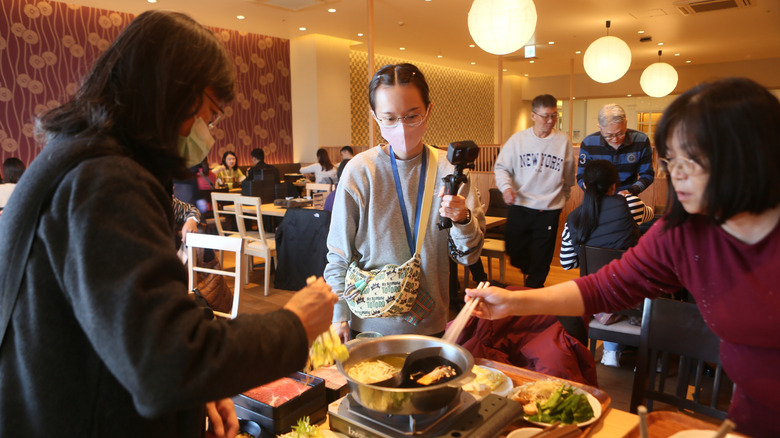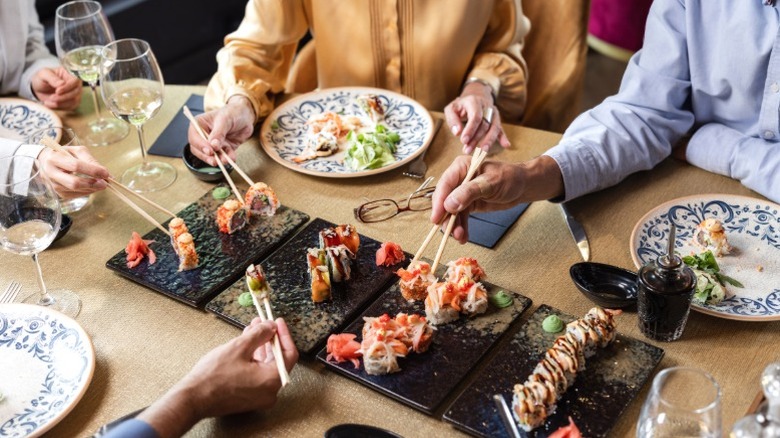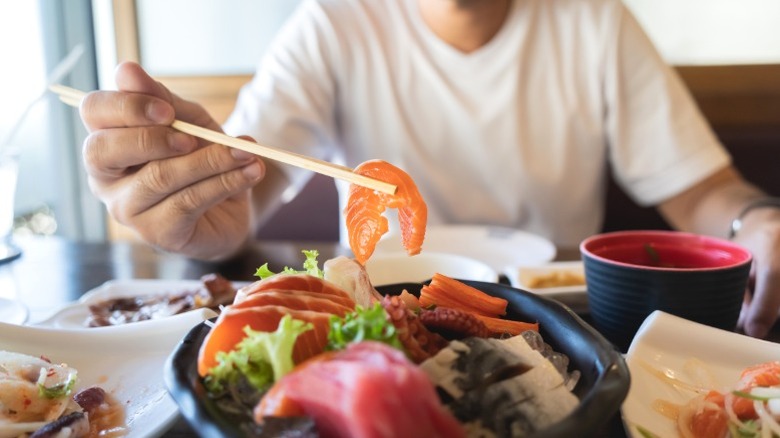The Unspoken Rule Tourists Should Follow To Avoid An Awkward Meal While Dining In Japan
Every destination has one thing or another that tourists look forward to when they visit. Among the many interesting things you'll enjoy when you go to Japan as a traveler is the country's amazing food culture. The sushi counters and the izakayas (Japanese pubs) in Tokyo and Kyoto are examples of a real promise of delight. Indeed, the dining experience in Japan is a satisfying one yet also heavily culturally influenced. Here, how you enjoy or share meals comes with a strong sense of etiquette. These unspoken rules, when followed, show respect to the people, the food, and, of course, the culture. It proves you're being a considerate visitor in Japan. But not all rules are intuitive, and some can be easy to break if you don't do your research. While it might seem harmless, even something as simple as hovering your chopsticks back and forth over shared dishes is actually a taboo you should avoid.
Among Japanese people, sharing meals is common. Tourists can experience this at izakayas, barbecue (yakiniku) joints, and hotpots (nabemono). When you look around and see small bowls, chopsticks, and dishes that are meant to be shared, it's easy to feel unsure of what you should or shouldn't do. This is where your knowledge of chopsticks etiquette comes in. While there are many rules to follow, hovering your chopsticks for several seconds over shared dishes on the table as you select your food is one habit you'll want to avoid. This is a dining faux pas known as mayoi-bashi. While this can already be irritating for others who have to sit patiently as you make your choice, it also may suggest that you're selfishly looking for the best bites without caring about everyone else waiting for their turns.
Why your manner of handling chopsticks matters in Japan
Remember that the Japanese people are highly cultural, and part of their values is group harmony. This mentality comes into play in meals too, explaining why mayoi-bashi is frowned upon. During shared dining, dishes are placed in the center for everyone's access, establishing a sense of community. The expectation is that the meal would go on smoothly without anyone disrupting the flow. As a result, stalling with your chopsticks during your turn just comes across as having poor table manners or being greedy, even if no one says anything.
Closely related to mayoi-bashi is the seemingly harmless act of trying to pick a preferred piece of the meal by digging through with your chopsticks. This is known as saguri-bashi, which is also a common dining mistake when eating out in Japan. Similarly, if you touch food with your chopsticks but eventually don't pick it up, you'd be committing an etiquette breach called sora-bashi. All of these rules are important to note. Of course, in some Western countries, picking through a dish or hesitating when picking may not raise eyebrows, but as the saying goes: When in Rome, do as the Romans do.
How to use chopsticks appropriately in Japan
If hesitating over a dish is enough to create a bad look, you can be sure there are plenty of other unspoken rules you may be overlooking. When eating from shared plates, don't use your personal chopsticks to serve yourself, because that's considered unhygienic and bad manners, especially if you've already put them in your mouth. This error is a taboo known as jika-bashi. You should rather use the provided serving utensils or look for an extra pair of chopsticks. In extreme conditions, you can use the opposite end of your chopsticks to pick up food from the communal dish, but only as a last resort. And definitely don't make things worse by hovering over the dish with the wrong end!
When picking up food, you should always do so as smoothly and quickly as possible. If you have to scan the dish, do that briefly without hovering your chopstick or touching any food piece at all. Be decisive, go straight for your choice, and transfer it to your plate before eating it without delaying others. While you're holding your chopsticks, avoid waving them in the air or pointing them around; when you're not using them, just put them neatly on the chopstick holder or across your bowl. It's also good to stay conscious of the fact that modesty is a key aspect of Japanese culture, so if someone compliments your chopstick skills, or how well you're following the etiquette rules, the most polite response is to deflect with humility or simply give a sincere smile instead of boasting or even saying "thank you". Like it or not, boldly claiming a compliment is one of the things you're not expected to do in Japan.


